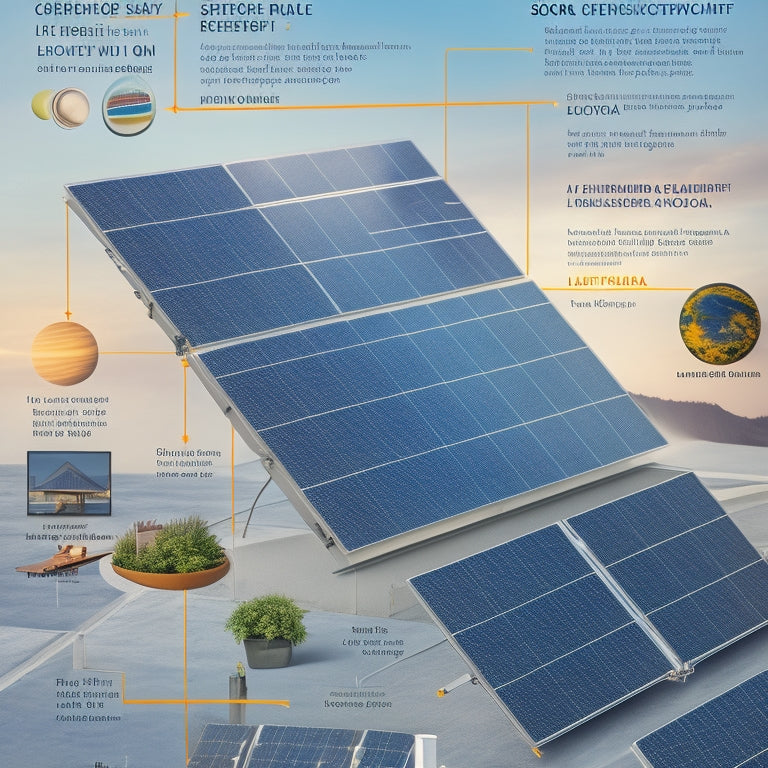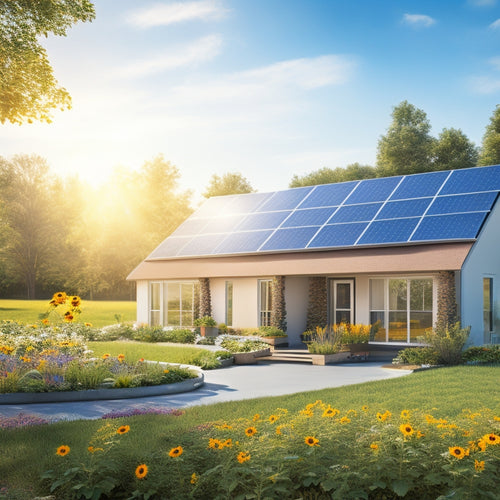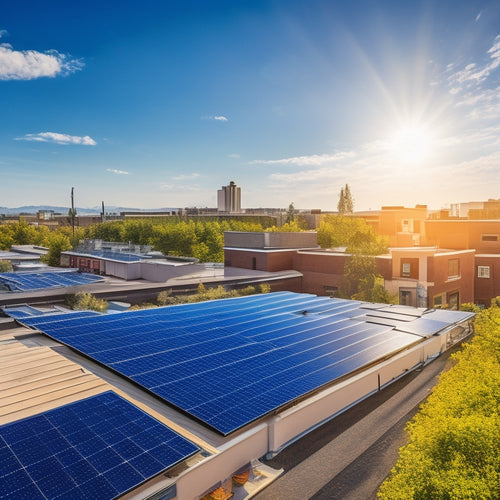
The Cost of a Solar System: 7 Essential Components and Prices
Share
When contemplating a solar system, you're likely wondering about the costs involved in each essential component. You've got seven key elements to examine: solar panels, mounting hardware, inverters, monitoring devices, battery storage, electrical wiring, and installation labor and permits. The costs vary widely, from $1.50 to $3.50 per watt for solar panels, $3,000 to $6,000 for ground mounting foundations, and $500 to $2,000 for monitoring systems, to name a few. As you investigate these components, you'll uncover how each affects your overall system performance, budget, and energy efficiency.
Key Takeaways
- High-efficiency solar panels cost $2.50 to $3.50 per watt, while lower-efficiency panels cost $1.50 to $2.50 per watt.
- Mounting hardware and racking systems can cost $3,000 to $6,000 for ground mounting and $1,000 to $2,000 for roof mounting.
- Inverters, which convert DC to AC power, can cost $1,000 to $3,000, depending on the type and quality.
- Monitoring and tracking devices, which provide real-time performance data, can cost $500 to $2,000.
- Installation labor and permits can add $2,000 to $5,000 to the total project cost, depending on the complexity of the installation.
Solar Panels Costs and Quality
Typically, homeowners considering a solar system installation are keenly interested in the cost of solar panels, as they comprise a significant portion of the overall system expense.
You're likely wondering how much you'll need to invest in high-quality panels that'll maximize your energy output. The cost of solar panels varies depending on the brand, model, and efficiency rating.
High-efficiency panels from top brands like SunPower, Panasonic, and LG can range from $2.50 to $3.50 per watt, resulting in a total cost of $15,000 to $21,000 for a 5-kilowatt system.
Mid-range panels from manufacturers like Trina, Hanwha Q CELLS, and Jinko can cost between $2.00 to $3.00 per watt, with a total system cost of $10,000 to $15,000.
Lower-efficiency panels from budget-friendly brands like Canadian Solar and ReneSola can be priced around $1.50 to $2.50 per watt, with a total system cost of $7,500 to $12,500.
When selecting solar panels, consider the trade-off between upfront cost and long-term energy production. Higher-efficiency panels may cost more initially but can generate more power over their lifespan, ultimately saving you money on your electricity bills.
Mounting Hardware and Racking Systems
You'll need to decide on a mounting system that suits your solar panel array, and you have two main options: roof mounting and ground mounting.
Roof mounting options include flush mounts, tilt mounts, and rail-based systems, each with its own benefits and drawbacks.
Ground mounting systems, on the other hand, involve anchoring the array to the ground, often using a racking system specifically designed for this purpose.
Roof Mounting Options
Roof mounting options, an essential component of your solar system, involve selecting the right mounting hardware and racking systems to securely fasten your photovoltaic panels to your rooftop.
When choosing a roof mounting option, you'll need to contemplate factors like roof durability and aesthetic considerations to guarantee a seamless integration with your existing roof structure.
Installation challenges, such as maneuvering complex rooflines or multiple skylights, must also be taken into account. Be sure to research local regulations and building codes to verify compliance.
Proper solar panel orientation is critical, so you'll need to contemplate the ideal angle and direction for your panels to maximize energy production.
Weather resistance is also a key factor, as your mounting system must be able to withstand harsh weather conditions.
Maintenance requirements should also be evaluated, as some mounting systems may require more frequent inspections or repairs.
Ground Mounting Systems
Frequently, homeowners opt for ground mounting systems when their rooftops are not suitable for solar panel installation, whether due to structural limitations or obstructions. This option provides more flexibility regarding panel orientation, tilt, and layout, allowing for peak energy harvesting. However, it is crucial to evaluate the added complexity and costs associated with ground mounting systems.
Ground Mounting System Costs and Considerations
| Component | Cost Range |
|---|---|
| Foundation (e.g., concrete piers) | $3,000 - $6,000 |
| Racking and tracking system | $2,000 - $4,000 |
| Installation labor | $2,000 - $4,000 |
| Electrical infrastructure (e.g., wiring, conduit) | $1,000 - $2,000 |
| Permitting and inspection fees | $500 - $1,000 |
When evaluating ground mounting systems, you should conduct a thorough solar site assessment to identify potential installation challenges, terrain considerations, and foundation requirements. Additionally, take into account local regulations, environmental impact, and maintenance tips to guarantee a successful and efficient installation.
Inverters and Power Conversion
When you're considering the cost of a solar system, you'll need to factor in the inverters and power conversion components.
These devices enable grid tie functionality, allowing your system to synchronize with the grid and feed excess energy back into it.
They also facilitate DC to AC conversion, converting the DC power generated by your solar panels into usable AC power for your home or business.
Grid Tie Functionality
Grid tie functionality is what enables your solar system to synchronize with the grid's electrical frequency, allowing you to sell excess energy back to the utility company. This functionality is essential for homeowners who want to maximize their energy savings and even earn some money by selling excess energy back to the grid.
With grid tie functionality, you can offset your energy consumption during the day and draw from the grid at night or during periods of low energy production. One of the significant grid tie benefits is that it allows you to take advantage of net metering, which means you can sell excess energy back to the utility company and receive a credit on your bill.
However, there are also grid tie drawbacks to evaluate. For instance, if the grid goes down, your solar system will shut off to prevent backfeeding the grid and potentially harming utility workers. Additionally, grid tie systems typically require more complex and expensive equipment compared to off-grid systems.
Despite these drawbacks, grid tie functionality is an important component of many solar systems, offering homeowners a reliable and efficient way to utilize the power of the sun while still relying on the grid as a backup.
DC to AC Conversion
As you evaluate the intricacies of your solar system, you'll need to convert the DC power generated by your solar panels into AC power, which is usable in your home - a process known as DC to AC conversion.
This is where inverters come in, playing an essential role in guaranteeing energy efficiency and power enhancement. There are different inverter types, including string inverters, microinverters, and power optimizers, each with its own benefits and drawbacks.
When it comes to installation techniques, proper sizing and configuration are key to maximizing system performance.
Regular maintenance practices, such as cleaning and inspecting the inverters, are vital to prevent downtime and guarantee peak energy production.
As your system ages, you may need to evaluate system upgrades or replacement of inverters to maintain peak performance.
Performance monitoring is also significant, allowing you to track your system's energy output and identify areas for improvement.
Monitoring and Tracking Devices
Your solar system's performance relies heavily on monitoring and tracking devices, which serve as its nervous system. These smart technology components enable you to optimize energy efficiency by providing real-time performance monitoring and data analytics.
With remote access, you can track your system's performance anywhere, anytime, ensuring timely system maintenance and reducing downtime. A user-friendly interface allows you to easily access critical system data, including energy production, consumption, and storage.
Advanced monitoring systems can even detect potential issues before they occur, enabling proactive maintenance and minimizing repair costs. By leveraging these observations, you can fine-tune your system's performance, maximizing your return on investment.
The cost of monitoring and tracking devices varies depending on the type and complexity of the system. On average, you can expect to pay between $500 and $2,000 for an all-encompassing monitoring system.
While this may seem like a significant upfront investment, the long-term benefits of improved energy efficiency and reduced maintenance costs make it a worthwhile expenditure.
Battery Storage System Options
With the rise of renewable energy, homeowners and businesses are increasingly turning to battery storage systems to optimize their solar power usage. You have two primary options: lithium-ion batteries and lead-acid batteries.
Lithium-ion batteries offer higher system efficiency, longer cycle life, and lower maintenance costs. They're ideal for daily energy management, providing a higher storage capacity and deeper discharge capabilities. However, they come at a higher upfront cost.
Lead-acid batteries, on the other hand, are a more budget-friendly option. While they've a shorter cycle life and lower system efficiency, they're still a reliable choice for backup power and off-grid systems.
When selecting a battery storage system, consider your energy needs, budget, and warranty options. Look for systems with a minimum 10-year warranty and maintenance costs that fit within your budget.
Be sure to assess your storage capacity requirements, as undersizing can lead to reduced system efficiency and lifespan. By choosing the right battery storage system, you'll be able to maximize your solar power usage and reduce your reliance on the grid.
Electrical and Wiring Components
The solar system's electrical and wiring components play an essential role in guaranteeing a safe, efficient, and reliable power supply. You need to verify that your system's electrical components are designed and installed to meet your specific power requirements. This includes the main service panel, circuit breakers, and wiring that connect your solar panels to your inverter and battery storage system.
When it comes to wiring safety, you should prioritize the use of high-quality, UL-listed wiring and connectors that can withstand outdoor environments and high temperatures. Proper wiring also guarantees electrical efficiency by minimizing energy losses due to resistance.
You'll need to take into account the gauge and type of wire, as well as the routing and securing of cables to prevent damage and electrical shock.
The cost of electrical and wiring components varies depending on the size and complexity of your system. On average, you can expect to pay between $1,500 and $3,000 for a residential solar system. This includes the cost of wiring, circuit breakers, and connectors, as well as the labor required to install and test these components.
Installation Labor and Permits
Properly installed electrical and wiring components are only half the battle; the actual installation process itself requires careful planning and execution.
You'll need to take into account installation regulations, labor rates, and permit requirements, which vary by region. Labor rates typically range from $2,000 to $5,000, depending on the complexity of the installation, local market conditions, and contractor qualifications.
Before installation, you'll need to obtain necessary permits, which can add up to $1,000 to your total cost. This includes electrical and building permits, as well as inspection processes.
Fortunately, local incentives may help offset these costs. Installation timelines can range from a few days to several weeks, depending on the size of your system and the contractor's workload.
When selecting a contractor, verify they've the necessary qualifications, experience, and insurance. A reputable contractor will guide you through the installation process, guaranteeing compliance with local regulations and permitting requirements.
Be sure to ask about their installation process, timeline, and warranty before signing a contract.
Frequently Asked Questions
Can I Install a Solar System Myself to Save Money?
You can attempt a DIY solar installation, but be aware that you'll face installation challenges, such as ensuring electrical connections are secure and meeting local building codes, which may outweigh the potential cost savings.
How Long Does It Take to Install a Typical Solar System?
When you hire a professional, you'll typically see a solar system installation timeline of 1-3 days, but be prepared for installation challenges that may extend this timeframe, depending on your roof's complexity and local permitting processes.
Are There Any Additional Costs for Removing Old Roofing Materials?
You'll likely face additional costs for removing old roofing materials, like in the case of a California homeowner who paid $2,500 for roofing disposal costs due to installation challenges, so factor that into your overall budget.
Do Solar Systems Require Regular Maintenance or Repairs?
You'll need to perform routine solar system maintenance to guarantee peak energy production, which may involve occasional repairs; expect to pay around $100-$300 per year for maintenance and repair costs, depending on the system's complexity.
Can I Expand My Solar System in the Future if Needed?
You can easily expand your solar system in the future if needed, allowing for future upgrades to increase your solar capacity as your energy demands grow, with most systems designed to accommodate additional panels or inverters.
Conclusion
As you flip the switch on your new solar system, the hum of electricity coursing through the wires is music to your ears. You've maneuvered the complex terrain of components and prices, and now you're reaping the rewards of capturing the sun's energy. Like a skilled builder of old, you've constructed a system that will stand the test of time, generating power and savings for years to come. With the right pieces in place, you're ready to bask in the glow of renewable energy.
Related Posts
-

Home Solar Systems for Environmental Impact
Home solar systems markedly reduce your carbon footprint by utilizing renewable energy. By adopting solar energy, you...
-

Solar Power Backup Solutions During Outages
Solar power backup solutions guarantee you have reliable energy during outages, providing essential power when the gr...
-

Solar Energy Solutions for Small Businesses
Switching to solar energy can be a game changer for your small business. You'll enjoy significant cost savings on mon...


